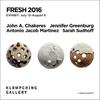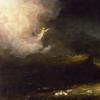Jacques' Menagerie opens at Museum of Russian Icons on March 16
- CLINTON, Massachusetts
- /
- March 05, 2019
The Museum of Russian Icons will be presenting Jacques’ Menagerie: Hnizdovsky Prints from the Christina and George Gamota Collection, March 16 – July 7, 2019, featuring works by acclaimed Ukrainian-American painter and printmaker Jacques Hnizdovsky. Curated by Anna Winestein, director of the Ballets Russes Arts Initiative, the exhibition includes 40 of the artist’s iconic prints depicting animals, plants, cityscapes, and narrative scenes, alongside an early oil painting and several rarely seen early works.
Born in Ukraine, trained in Poland and Croatia, Jacques Hnizdovsky (1915-1985) was a refugee to the US who traveled a difficult road through life. Embraced by American viewers and collectors, his art expressed his capacity for joy, humor, and hope, most often in black and white. His boldly graphic and playful images, most famously a series of portraits of animals from the Bronx Zoo, have been widely recognized and beloved for over half a century.
This exhibition presents highlights from a single collection of Hnizdovsky prints (woodcuts, linocuts, and etchings), as well as one of his paintings, which are rarely exhibited. The collection was assembled by Christina and George Gamota, a Ukrainian-American family who had a personal connection with the artist and shared Hnizdovsky’s experience of displacement, hardship, and adaptation in the course and aftermath of World War II, passing through the same displaced persons camps. The works, mostly images of animals and plants, as well as an occasional portrait or still-life, acquired very personal symbolism for different members of the Gamota family. This show, presented in partnership with the Ballets Russes Arts Initiative, tells the story of both Hnizdovsky and the Gamotas in the intimate setting of the Museum’s Contemporary Exhibition Gallery.
Special programs include a celebratory opening with a collectors roundtable on April 6th, a curator lecture on Hnizdovsky in Context on May 4th, and a concert by renowned cellist Yosif Feigelson on June 22nd.
ABOUT THE ARTIST
Jacques Hnizdovsky was born on January 27, 1915 in the village of Pylypcze in western Ukraine, the youngest of seven in a family of titled landowners of Polish descent. The family’s lands were near the city of Borshchiv, then under Russian Imperial rule and today part of Ternopil Oblast, Ukraine. Just two years later, two Revolutions in 1917 unleashed a time of great upheaval and war, with several self-proclaimed independent Ukrainian states, the Red Army of the nascent Soviet Union, the White Army, and a newly independent Poland all battling for control of the region. The 1921 Treaty of Riga assigned the region to Polish rule, which ended with the Soviet invasion in September 1939, followed by German occupation 1941-1944, and permanent absorption into the Soviet Union at the end of World War II. Under Soviet rule, his family’s estate would be confiscated and many relatives would find themselves in Siberian exile. Leaving for seminary in Poland in 1929 protected Hnizdovsky from some of this, but at a price. After the age of 14 he never saw his family again.
Hnizdovsky earned a scholarship to the Academy of Fine Arts in Warsaw, where he pursued his artistic training until the German bombing of Warsaw drove him to Zagreb. There he continued his studies at the Croatian Academy of Fine Arts, working mostly on painting and sculpting human subjects and evincing an early interest in portraiture. Although he would go on to become an internationally recognized print artist, that would be later and without formal instruction. Influenced by the works of Dürer, Ukrainian baroque engravings, Japanese Ukiyo-e and Chinese brush painting Hnizdovsky was, in fact, entirely self-taught in printmaking.
After surviving the War and then years in a displaced persons camp, Hnizdovsky arrived in the US in 1949, penniless, yet determined to succeed as an artist. The turning point in his career and his life came when a leading curator from the Metropolitan Museum of Art, A. Hyatt Mayor, chose one of his woodcuts for a Purchase Award at a Minneapolis Institute of Arts exhibition. Hnizdovsky gave up his work as a commercial artist in Minnesota, and moved to New York City to pursue fine art full time. In the 1950s he also spent time in Paris (where he met his wife), painting its architecture and public spaces. In 1962 his print, The Sheep, received First Prize at the annual exhibit of The Boston Printmakers Association, going on to become one of his most prized creations.
Best known for woodcuts of flora and fauna, Hnizdovsky produced hundreds of paintings, watercolors, pen and ink drawings on different subjects, as well as over 375 full-format prints (almost 250 woodcuts, plus linocuts and etchings) and numerous bookplates (ex libris), many of them also small woodblocks.
The artist created illustrations for numerous books during his lifetime, including The Poems of John Keats, 1964; The Poems of Samuel Taylor Coleridge, 1967; Flora Exotica, 1972; The Poems of Thomas Hardy, 1979; The Traveler’s Tree, 1980; The Poetry of Robert Frost, 1981; Signum Et Verbum, 1981; and his works have continued to be used extensively as illustrations in new volumes since.
Hnizdovsky’s works have been exhibited widely and are in the permanent collections of many museums worldwide, including the Addison Gallery of American Art, Chrysler Museum, Cleveland Museum of Fine Arts, the Nasher Museum of Art at Duke University, Hunt Institute for Botanical Documentation, Henry Art Gallery, Louisiana Arts and Science Center, Minneapolis Institute of Arts, Museum of Fine Arts, Boston, National Museum of American Art, New Orleans Museum of Art, New York Public Library, Philadelphia Museum of Art, The U.S. Information Agency, Library of Congress and White House, Virginia Museum of Fine Arts, Winnipeg Art Gallery, and Yale University, among others. His work was included in several international traveling exhibitions, among them a 1963 Contemporary American Graphic Arts show touring the U.S.S.R.
Jacques Hnizdovsky passed away on November 8, 1985, just days after printing his last woodcut, Washington Monument, a tribute to his adopted country. His archives are housed at the Slavic and Baltic Division of the New York Public Library.
ABOUT THE COLLECTORS
Christina and George Gamota were born on either side of the modern border between Ukraine and Poland, leaving the region during World War II, and spending years after the War in displaced persons’ camps in Austria and Germany. George’s family immigrated to Minneapolis, Minnesota in 1949, the same year that Christina and her parents arrived in Buenos Aires, Argentina. In 1959, her family resettled again, to Minneapolis, where she would soon met her future husband. Married in 1961, they began collecting in 1964, the same year the oldest of their three children was born, while George was a doctoral student in physics at the University of Michigan. Their first acquisition was a large Cubist-style oil painting by David Holsworth that cost the equivalent to the couple’s budget for food for half a year.
Although the Gamotas' parents knew of Hnizdovsky through the tight networks of displaced Ukrainians in Minnesota, the couple first encountered the artist’s prints in the early 1970s in a New York gallery, Associated American Artists. Christina and George immediately fell in love with Hnizdovsky’s boldly graphic art, and acquired their first piece, Two Rams. More purchases of his playful and affordable works would follow, from the gallery, and, eventually, directly from the artist. Many of the pieces came to have associations between the animals or objects depicted and characteristic traits of members of the family or experiences they fondly remember. Their only painting by the artist, a basket of potatoes, was acquired by Christina in the mid 2000’s in memory of her father, poetically representing her homeland.
Even as the couple’s collecting of both visual art and design took off and diversified, and their homes—whose interior design was always done exclusively by Christina—grew larger and grander, Hnizdovsky remained a beloved artist in the family. Already in December 1974, when the Gamotas’ New Jersey home was showcased in an extensive article in Glamour—possibly the first time that a regular family was featured in a holiday issue; the interior design of the entire house had been created by Christina herself, without professional decorators, and Hnizdovsky works figured prominently in several of the photographs showcased in the glossy magazine. Soon after, the family moved to the Washington DC area, where George served as the Founding Director of Research at the Department of Defense (DoD). The couple’s Reston, Virginia residence would be the first to have a dedicated wall of Hnizdovsky. Christina continued to systematically acquire works by Hnizdovsky, filling gaps in the collection from a design and historical perspective, even as the couple moved again, to Ann Arbor, MI in 1981, and Lexington, MA in 1986. Although select works were always displayed throughout the house, the expanding Hnizdovsky collection wall would become such a centerpiece that the interior would be rebuilt or custom-built specifically for it.
ABOUT THE CURATOR
Anna Winestein is an historian of art and theater, independent curator, and cultural entrepreneur. She is Executive Director and co-founder of the Ballets Russes Arts Initiative (www.ballets-russes.com), a Boston-area non-profit that follows in the tradition of Diaghilev’s Ballets Russes by promoting international creative exchange in the fine and performing arts, especially with the post-Soviet region.
Exhibitions Ms. Winestein has curated include The Golden Age of the Ballets Russes for Sotheby’s Galerie Charpentier in Paris, and The Magical Reality of Alexandre Benois at the Boston Public Library, for which she authored the catalogues. In 2017, she curated Migration and Memory: Jewish Artists of the Russian and Soviet Empires at the Museum of Russian Icons. Co-editor and co-author of The Ballets Russes and the Art of Design, as well as Loyalties and Solidarities in Russian Society, History and Culture, Ms. Winestein has published articles in academic journals and contributed essays to numerous exhibition catalogues and joint volumes. Her research interests include visual art of the Russian and Soviet Empires, and post-Soviet region 1850 to today, European modernism, 20th century dance and theater history and cultural exchange of Russia with Europe.
Ms. Winestein has been a Cultural Envoy for the US State Department and is a former Fulbright Scholar. She also consults collectors, dealers and museums, and previously served as Creative Director for the Hermitage Museum Foundation. She holds a BFA in Painting, BA in Art History and MA in Economics from Boston University, and wrote a dissertation in Modern History at Oxford University on social and professional networks among Russian artists in Paris 1870-1917, receiving an M. Litt in 2018. Ms. Winestein is an associate of the Davis Center at Harvard University and the Center for the Study of Europe at Boston University.
ABOUT THE MUSEUM OF RUSSIAN ICONS
The Museum of Russian Icons inspires the appreciation and study of Russian culture by collecting and exhibiting icons and related objects; igniting the interest of national and international audiences; and offering interactive educational programs. The Museum serves as a leading center for research and scholarship through the Center for Icon Studies and other institutional collaborations. It is the only museum in the US dedicated to Russian icons, and it is the largest collection of icons outside of Russia.
Museum hours: Tuesday–Friday, 11AM to 4PM; Saturday and Sunday, 11AM to 5PM. First Sunday of the month: free admission! Closed Mondays.
Admission: Adults $10, seniors (59+) $7, Students $5, Children (3-7) $5, Children under 3 Free.
For more information, please visit museumofrussianicons.org. Follow the Museum of Russian Icons on Facebook, Twitter, and Instagram.
Press Contacts:
Nina J Berger, Communications Consultant | ninajberger@gmail.com | 617.543.1595
Mary Delaney, Marketing Director | mdelaney@museumofrussianicons.org | 978.598.5000 x121
HIGH RESOLUTION IMAGES & INTERVIEW ON REQUEST
THE MUSEUM OF RUSSIAN ICONS
230 Union Street, Clinton, MA 01510 | www.museumofrussianicons.org |978.598.5000
Image credit: Jacques Hnizdovsky, Loon, 1985, woodcut. © 2019 Jacques Hnizdovsky / Artists Rights Society (ARS), New York
Contact:
Nina BergerMs.
6175431595
ninajberger@hotmail.com
203 Union Street
Clinton, Massachusetts
info@museumofrussianicons.org
978.598.5000
http://www.museumofrussianicons.org/
About Museum of Russian Icons
The Museum of Russian Icons inspires the appreciation and study of Russian culture by collecting and exhibiting icons and related objects; igniting the interest of national and international audiences; and offering interactive educational programs. The Museum serves as a leading center for research and scholarship through the Center for Icon Studies and other institutional collaborations. It is the only museum in the US dedicated to Russian icons, and it is the largest collection of icons outside of Russia. Museum hours: Tue. - Fri., 11AM to 4PM, first Thurs of the month to 8PM, Saturday and Sunday 11AM to 5PM, closed Mondays. Admission: Adults $10, seniors (59+) $7, Students $5, Children (3-7) $5, Children under 3 Free. For more information please visit museumofrussianicons.org.
















